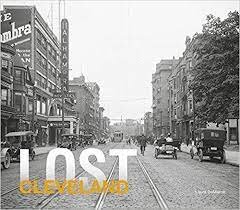Lost Cleveland, by Laura DeMarco
Review by Greg Deegan
If you are a member of the Teaching Cleveland community, you would likely find fascinating the fact that Cleveland’s claim to being the home of rock ‘n roll rests at a nondescript building on Prospect Avenue — once home to Record Rendezvous, whose owner insisted to his DJ friend Alan Freed that he play “race records” on the air — that today sits dilapidated and without any signage.
Or you might find yourself interested in sharing at a cocktail party (are those a thing any more?), some Cleveland history trivia. For instance, did you know that Hector Boardi, who would gain national fame as “Chef Boyardee,” crafted his culinary specialties for the swanky Marble Room of the Hotel Winton on Prospect and East 10th in the 1920s? Maybe as you drive friends around town regaling them with fascinating Cleveland tidbits, you would want to know that at one time, the Humphrey family (of Euclid Beach fame) built the Elysium Arena ice rink at Euclid and East 107th, which they called the “largest artificial ice rink in America.”
There’s a lot more where that came from. That’s actually an understatement. Laura DeMarco’s Lost Cleveland will serve current and future generations of Clevelanders as an absolute treasure trove of intriguing aspects of this town’s history. Most people who know something about Cleveland’s history understand that the city has changed dramatically in the 20th and 21st centuries. Her book helps understand these massive changes by shrinking the narrative to bite-sized vignettes about the city’s important physical landmarks, the people behind them, and how the structures vanished.
Organized by decades starting in the 20th century, DeMarco identifies markets, factories, parks, transit routes, skyscrapers, churches, factories and much more that have been lost to history. The oversized book features large, clear images of bygone scenes and structures that Clevelanders at the time probably once took for granted. Who could have imagined that Luna Park would be replaced with the Woodhill Homes? Who could have thought the Theatrical, which drew thousands for almost 60 years on Short Vincent, would disappear from the downtown scene? Or who would have guessed that the City of Cleveland steamship, which took passengers on overnight trips to Detroit, would not carry passengers past 1950? Ok — maybe you could predict that one.
Either way, the book is a must for anyone who loves Cleveland history. It’s essential for anyone who wants to dive into Cleveland history in order to enjoy, share, and even get into a car and travel to the identified sites to see what they look like today.
I can’t be the only one who would do that, am I?
